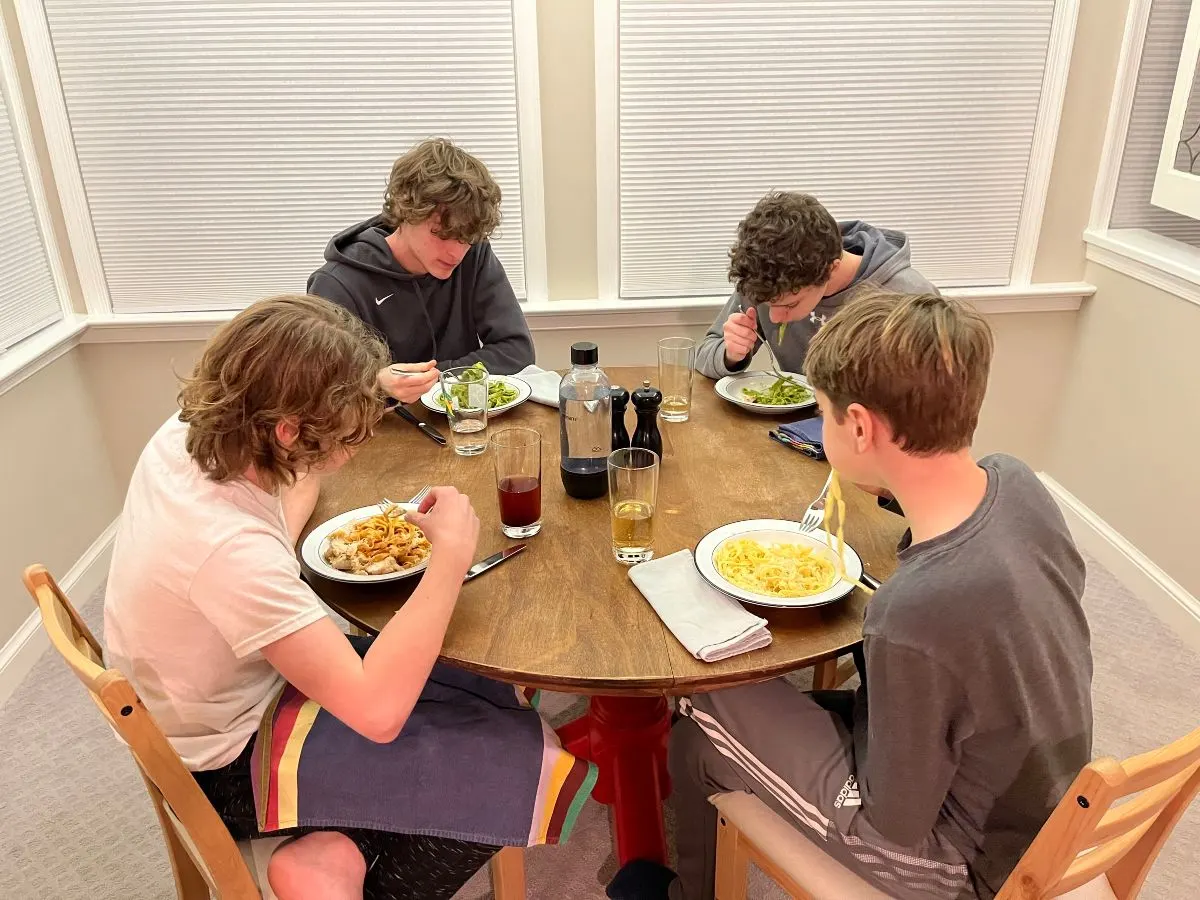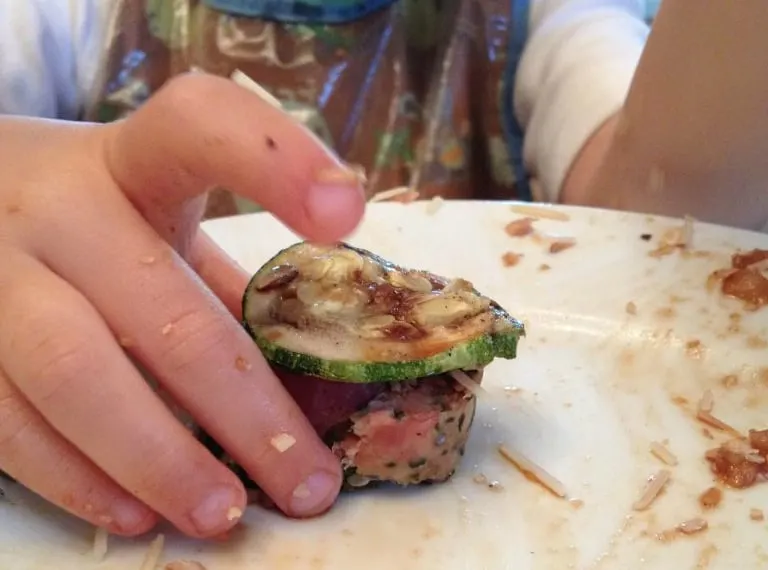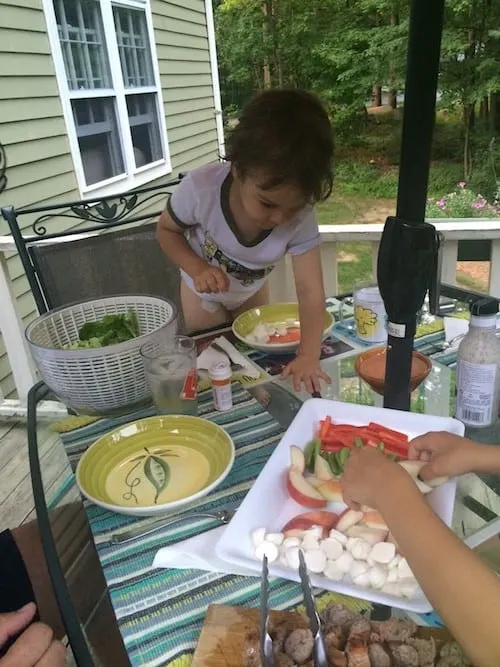Feeding selective picky eaters may be one of the most challenging aspects of parenting. While it can feel really hard, scary, and even counterintuitive, allowing picky eaters autonomy when it comes to eating can be an incredibly powerful tool in helping them to expand their palates. Learn why this is true and read about two cases where allowing more autonomy around food proved to be the winning strategy.

The Division of Responsibility Approach to Feeding Kids
When one of my sons was younger he was a very picky eater. Not only did it make mealtimes unpleasant, but there were concerns about his growth, so the pressure was on to get him to eat! After a number of failed approaches, I decided to try the Division of Responsibility approach.
What is the Division of Responsibility Approach
The Division of Responsibility approach was developed by Ellyn Satter, a dietician and therapist, who worked with countless families who struggled with feeding issues. As part of her work, she came up with principles that families could use to reduce tension at the table and encourage the exploration of food.
In her model, the parents/guardians/grownups are responsible for some aspects of the meal, while the child is responsible for others, allowing them to have some autonomy in their eating.
Parents/Guardians/Grownups Have the Following Responsibilities:
- Select and prepare the food that is made available
- Provide meals and snacks on a regular basis (have a set meal times)
- Focus on making eating times pleasant/conflict free
- Show your children how you would like them to behave at mealtimes both by explaining expectations and by modeling the behavior you would like to see
- Be patient and understanding that your child lacks the food experience that you do, but don’t cater to likes and dislikes
- Avoid snacks and drinks (other than water) between meal and snack times (this allows your child time and space to actually get hungry)
- Let your child grow into the body that is right for her/him, even if it isn’t the body you wish they had
Kids Have the Following Responsibilities
- Eat
- Eat the amount s/he needs
- Learn to eat the food you enjoy (note: this can take a long time, which is where the being patient noted above comes in)
- Grow predictably in the way that is right for him/her
- Learn to behave well at mealtime (no disparaging remarks about the meal, no throwing food, no tantrums, etc.)
In short, I realized I had to make food available (at set mealtimes) and then allow my son to eat when and how much he wanted. It felt risky and scary to let go of so much control, but the battles weren’t working, so I knew I needed to try something else.
For a long time it was really difficult to let go of the control. And then there was a week when two things happened and it suddenly all clicked. I realized that the key to the Division of Responsibility approach was that it was giving my picky eater of a son autonomy over what went into his body.

A teenager who was open to change
The first thing that happened involved a one-on-one cooking lesson that I had with a 15-year-old boy. This was a kid who had a pretty limited palate and had shown very little interest in food. I had been working with his mom to come up with ways to feed him healthfully and offered to give him a cooking lesson as part of our work together. To her great surprise, he jumped at the opportunity.
When I arrived, he was eagerly waiting at the door and then started right into learning how to chop vegetables, make a sauce, and put together a healthy dinner. He was focused, cheerful, and engaged. It was such a wonderful experience!
Looking back, there were a couple of reasons that I think the session was such a success. One was that just by offering the possibility of the cooking class, he was given a chance to learn a new skill that would help him to become more independent.
Another was that he got to choose the meal he was going to make. I came up with a couple of recipes that were easy, fun to make, and would teach some cooking fundamentals, but he got to choose which one we made.
And finally, he got to select some of the ingredients, which meant he could tailor the meal to his tastes.

The power of condiments
The second was at our dinner table. I had roasted a ton of vegetables and cooked up some sausage. I knew that my picky eater son would likely try to eat only sausage and maybe some potatoes. So, I was prepared to offer him the other vegetables on the table, but to sit on my hands and bite my tongue if he chose not to eat them (as prescribed by the Division of Responsibility approach).
In the hopes that it might entice him to try the vegetables, I set out a bunch of condiments: olive oil, balsamic vinegar, salt, pepper, feta, and Parmesan.
As predicted, the first thing he did was happily inhale the sausage on his plate and nibble at the potatoes and one piece of squash. I chalked it up to a mediocre success of a meal, but then an amazing thing happened: he asked for more of everything. He had decided that what he wanted was to build little towers of food with lots of condiments.
We then watched in amazement as he built tower after tower of squash, potato, and sausage topped with balsamic vinegar and Parmesan. With each bite he had a twinkle in his eye, a twinkle that I had seen in the eye of the 15-year-old as well.

The importance of autonomy in helping picky eaters
And that was when it hit me—the autonomy I had given these two picky eaters was very important. They were able to customize the meal in a way that was appealing to them and, in doing so, were more open to trying new things.
What is more, as we embraced this approach more and more, we discovered that not only was it helpful for our picky eater son, but it was also positive for our more adventurous eater of a son. Both kids enjoyed and benefited from interacting with their food, being able to make choices for themselves, and having a sense of control over their bodies.
Now, realistically, not every meal will have multiple side dishes from which kids can choose. Sometimes a casserole is just a casserole or a soup is just a soup. But even in those meals, there are ways that we can offer choices:
- Put lots of spices and condiments out on the table so that everyone can make the meal their own
- Offer toppings such as grated cheese, crackers or croutons (for soups), and nuts or seeds
- Serve family-style so that everyone can take as much (or as little) as they want
- Offer simple side dishes that can help to supplement a meal (veggie sticks, bread, salad, fruit slices, etc.)
The point, in the end, is to continue to offer varied and healthy foods, and to give the creative freedom for eaters to be autonomous and make those foods their own.
Do you give your picky eaters autonomy with their food? If so, what are some of your simple tricks? Please leave your comments in the space below.
Want more ideas on how to feed your picky eater? Check out the picky eater solutions section of our site for lots of articles and information!
If you need more family-friendly meal ideas, check out The Scramble’s online meal planner for lots of kid and parent approved recipes.

Create Your Own Healthy Yogurt Bar
Wednesday 8th of June 2022
[…] that gives them the opportunity to make choices for themselves. Because, let’s be honest, we all do better and are happier when we are given choices, rather than when something is imposed upon […]
Salad Bars at Home Get Kids Eating More Veggies
Monday 29th of November 2021
[…] The Importance of Autonomy: Helping Picky Eaters to Try New Things […]
The Power of Condiments: Helping Picky Eaters to Explore New Foods
Thursday 17th of September 2020
[…] The Importance of Autonomy: Helping Picky Eaters to Try New Foods […]
Farmers' Market Scavenger Hunt with Kids
Wednesday 5th of August 2020
[…] Would you like more support to get your kids to try new foods? Check out my interview with my formerly picky eater and The Importance of Autonomy: Helping “Picky” Eaters to Try New Things. […]
How to Change the Dynamic at the Dinner Table
Wednesday 4th of March 2020
[…] the trying of new foods goes in your family is your choice (or check out our post on the importance of autonomy), but offering something “safe” to fall back on can earn you a lot of trust and reduce the […]